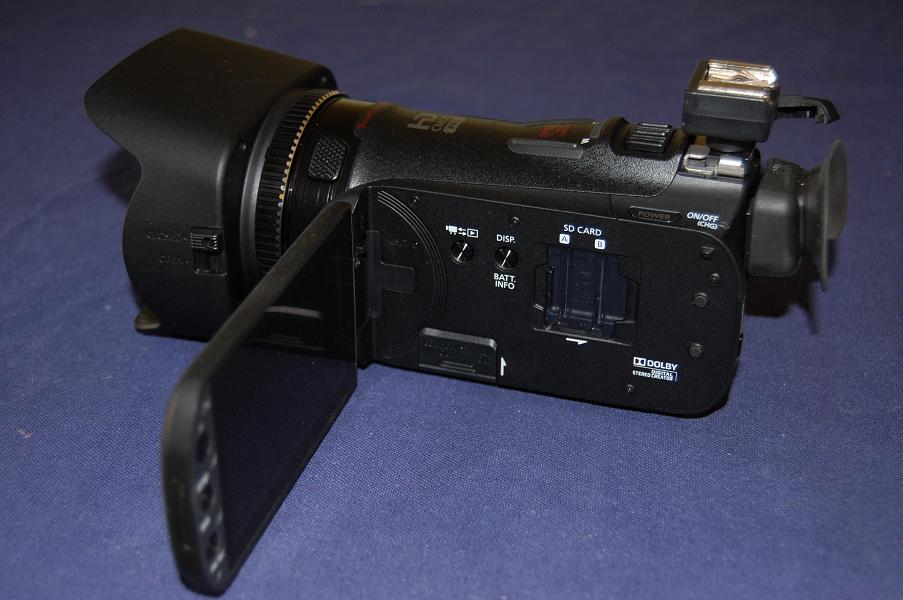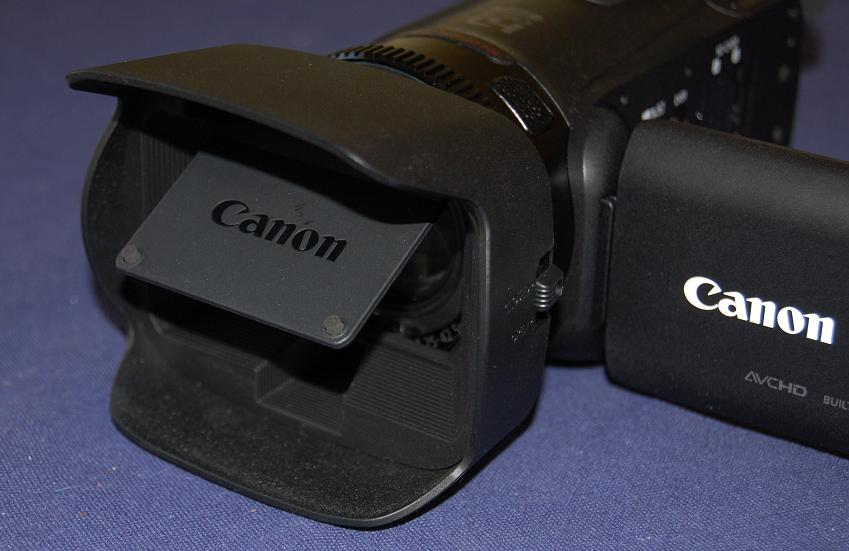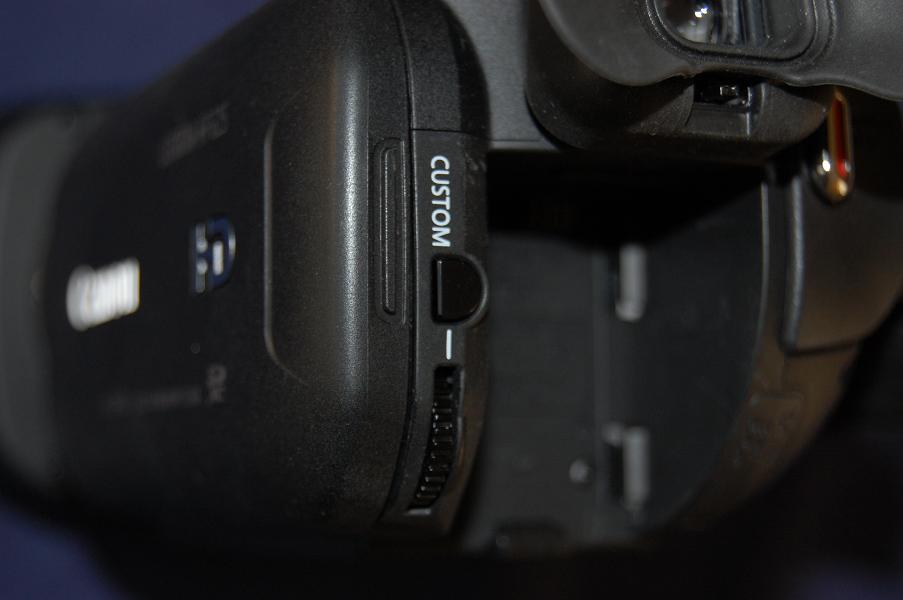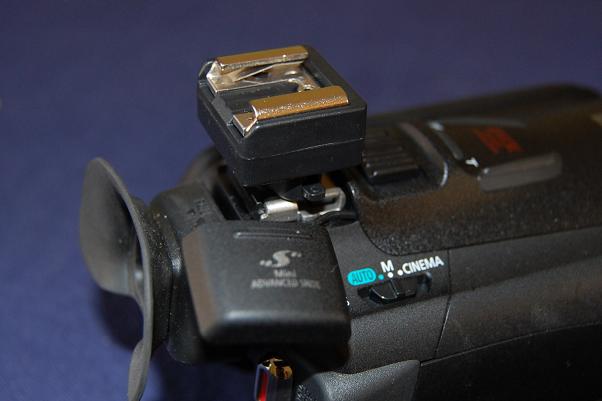Review: Canon Legria HF G25 (Vixia HF G20)
One step down from the flagship HF-G30 is the Legria HF-G25 (also known as the Vixia HF-G20 in the USA), launched at the US Consumer Electronics Show in early 2013.
Featuring a native 1920 x 1080 Full HD sensor, a 10x optical zoom lens, 32GB of built-in memory as well as dual SDXC/SDHC memory slots, microphone & headphone sockets and a variety of manual controls, the G25 is a capable piece of kit which can work for almost any situation.

But despite its novelty, there are in fact only two differences from the prior model, the G10: a claimed 20% improvement in low-light capabilties and an improved lens hood design with an integrated flip-down lens protector.

Compared to many modern point-and-shoot camcorders, it’s quite chunky in the hands (though anyone who recalls the older generation of bulky DV tape cams might laugh at such a description!) but this gives it a solidity and weight which is quite reassuring. A manual lens ring with a decent feel to it crowns the front of the device, and a small but accessible thumbwheel on the back provides additional manual functionality, configurable from a handful of options.

You can watch our editor’s first look at the camcorder here:
In use, the auto mode proves to be perfectly capable, with generally swift and accurate autofocus and decent exposure. The danger of auto is more apparent in lower light situations of course, where image quality will degrade and the camcorder will attempt to compensate by adding in bucketloads of electronic gain which adds noise, and, perhaps, a slower shutter speed which can lead to a blurring effect.
Better then, to switch the camera to manual using a slide switch on the back of the unit. In this mode it can still operate almost fully autonomously but you have the choice of taking over control should you so wish, for essentials such as iris, shutter and gain, as well as white balance, audio recording levels and focus.
Focus is achieved easily using the lens ring, with the camera providing both “focus assist” (which zooms part of the image on the screen so you can better see what you’re focusing on) and peaking (which surrounds items in focus with a red line, thus anything so marked can be taken as being in focus).
Unfortunately, the focus assist doesn’t operate during recording so if you need to recheck your focus or you change subject, you either have to guess or stop recording while you reset. Sadly, the peaking is either on all the time or off, it cannot be set to come on only when adjusting focus such as in tandem with the focus assist. It makes you wonder whether any camera operators actually had input into the design or whether the engineers were left to their own devices…
Exposure can be easily controlled via the control dial on the back, with electronic ND (neutral density) filters automatically coming into effect above F4, to stop down the light entering the camcorder and keep the iris at its sweet spot. Tools to assist include zebra lines switchable from 70% to 100% and a waveform monitor. Irritatingly again, those tools don’t appear on screen automatically as you adjust the exposure; you have to go into touchscreen menus to switch them on, which is frustratingly slow and infurirating. It surely wouldn’t take much of a software update to have the option for all these very useful focus and exposure tools to appear at the point of adjustment (just like the focus assist already does)?
Using the menus also highlights this camera’s other main flaw, it’s resistive touchscreen which is hopelessly awkward in its response, requiring a firm thumb or finger push to operate rather than the slick touch we have all become used to on contemporary mobile phones (the new G30 has a capacitive OLED screen which is far superior – at a price)
The video recording fomat is AVCHD up to 24Mbps or as low as 5Mbps which provides something like 12 hours recording time on the inbuilt memory. Although a 25p mode is included for that “film look”, it’s saved as an interlaced file so your editing software will need to understand what it’s looking at. No 50p mode is available, just the television-standard 50i. For creating DVDs and viewing on TV it’s perfectly fine then, and in fact, by the time a video has gone through an edit, output render, encode by YouTube, and display on who knows what kind of screen at the viewer’s end, de-interlaced 1080 50i looks perfectly fine to us too, so we wouldn’t worry too much about 50p unless you’re keen on doing lots of slow-motion filming for which it can be helpful.
Stereo audio is provided by two built-in microphones just behind the lens. Inside they’re OK but outside they need a fluffy wind jammer despite a menu setting to reduce the effects of wind noise. An external mic can be plugged in via the 3.5mm jack socket but take note that this socket does NOT provide so-called “plug in power” so only self-powered microphones will work. Also, the automatic mic settings are terrible and should immediately be switched off as a decent sound can be recorded if you muck about with the menus, as shown in this video:
Stabilisation on the camcorder is decent, with three levels of capability (standard, dynamic and powered) each of which is targeted at a different type of use. And the 10x optical zoom provides reasonable reach. Beware the menu option for 40x and 200x digital zooms though which do truly terrible things to the image and were a waste of Canon’s time to include, as demonstrated below:
One other irritation of the camcorder is its proprietary shoe design which Canon labels “Mini Advanced Shoe”. It is advanced in the sense that certain Canon accessories such as the DM-100 shotgun microphone plug directly into it so you don’t need to have a dangling wire going to the mic input but it’s not advanced in the sense that it’s a non-standard size so if you want to mount any other accessories to the top of the camcorder, you’ll need an adapter. Fortunately, these are relatively cheap.

In summary
The Canon Legria HF-G25 is capable of excellent images and has decent manual controls. It is not without flaws however and in terms of pure technology it is left behind by the likes of Panasonic’s x920 which boasts better image stabilisation, WiFi for remote control and live streaming, and 50p recording. Whilst the HF-G30 addresses those technology issues, it does so at a substantial price premium to the G25. If WiFi and 50p are not vital to you however, and you have a liking for Canon gear, then the G25 is a fine purchase.
You can buy the HF-G25 via this link: http://amzn.to/1piN8kN which is our Amazon UK affiliate; in other words we’ll get a few quid commission and will be forever in your debt (no, not literally). Should you prefer to flash the cash, the HF-G30 is available here: http://amzn.to/1nIWh7V
You can watch our entire, 13 video sequence about the G25, on YouTube here:
I have one word for the image played back via HDMI on my Panasonic 50 inch plasma, ‘Stunning’.
This will be edited with the sound soon, it will be interesting to see how much better it is than the other cameras used. I can post a link if it’s allowed and anyone is interested, to show the differences between cameras, the effect of great audio from a sound desk and generally what can be done in the real world.
Hi, I have the Canon Legria HF G25. When I have filmed someone I used to be able to play it back and hear the sound. Now I can only hear it through headphones. Can you help? Thanks
Forgive the obvious question but have you turned up the loudspeaker volume as described on page 88 of the manual? Have you set the AV terminal setting to AV instead of headphone?
hello there,
Will you please help me out with my Cannon Legria G25.
I have recorded few clips on the camera all good however now that i have to transfer them to my Mac I do not have any cable and the only option will be to transfer the clips on the SD card from the internal memory and the trouble is that I do not know how to do it.
Is very annoying since Im just starting my career and so far my videos think they a disaster or can get access to them
To use the files from the internal memory, you either need to buy a cable – very cheap – or copy the files onto an SD card. To do the copying, use the camcorder’s copy function (read the manual for this. It’s all explained in there).
Is it true that audio over HDMI can be passed only in 1080p mode?
I’m pretty sure that’s not the case. I’ve sent audio over HDMI on interlaced material I’m 99% certain. Whether it’s the case on this specific camcorder I don’t know, you’d need to consult the manual.
Legria hfg 25 camcorder working ok, now for some reason when I try to film or photo, viewer picture
Up side down how do I correct this. There does not seem to be answer in manual.
What, the image on the LCD screen is upside down?
Re Canon Legria HF G25
Could someone please guide me on how I can take off the output display icons from the recoding on AUTO mode. I do not want to see any icons in playback.
I use this camera for recording basketball games and I hate seeing all the icons on recording. The manual does not give instructions and by pressing the DISP. Battery Info button it removes them in Cinema and MAN but not AUTO.
Please help.
Thanks
I’m confused about whether you’re referring to the icons during recording (because of your commment about Cinema and Man modes, which are recording modes) or in playback (in which case Cinema and Man are irrelevant). You cannot turn the icons off while recording in Auto mode as the manual shows on page 82. In playback mode, pressing DISP will toggle between having just the data code on and all displays on. The controls may be displayed briefly but should disappear if you leave it alone for a few seconds.
HI. Very interesting discussion. I would be uploading to iMovie on iMac OS 10.11.5. I have a firewire to thunderbolt connection with my Canon Mini DV which works great. Wondering if the Legria memory card will work with the card reader on the iMac? and also if the firewire to thunderbolt connection will still be OK.
I don’t know what you mean about if the firewire to thunderbolt “will still be OK”. In what sense? What do you want it to do?
As regards the reader, the Legria uses standard SDHC cards so if your iMac has an SDHC / SDXC card reader, it will read the cards.
I tried to read through as many of these questions/comments as possible for an answer to my question, but I think I may have lost my place a few times… I apologize if it is a repeat question:
Is there a setting adjustment available to record to the SD card as an .mp4 file?
The included software is working properly, and my “old” Canon Vixia records to .mp4, which is QUITE convenient… Any way to do this with the HF G20?
Thanks!!
Not as I recall. It shoots AVCHD as .mts (I think) files. This shoudn’t present any problem in editing though. Why do you want mp4?
Just the format my old canon vixia recorded in. I could pop the SD card into my computer and just move the file into an editor, easily.
I had to plug my camera into the computer, and import my first video directly using Vegas.
Does the HFg30 record in .mp4 that you know of?
I really love this camera, otherwise. Am I making too much of this?
With apologies, I think you are! Is it so awful to bring files in via Vegas (since you’re then going to edit in Vegas presumably anyway)? You can still plug the card into the computer rather than connect the camcorder to the PC (but always use Vegas’s import function for AVCHD)
That said, yes the HF-G30 does have an mp4 mode, as follows (taken from the Canon specs on their website)
50p: 1920 x 1080, 35Mbps
25p: 1920 x 1080, 24Mbps
25p: 1920 x 1080, 17Mbps
25p: 1280 x 720, 4Mbps
25p: 640×360, 3Mbps
I have had my Legria HF G25 for over a year. I have videoed at least 12 weddings this year, numerous school play rehearsals (I am a teacher) and have nothing but praise for this camera in terms of usability and quality of the end product. I edit in Premier Pro and export through Adobe Media Encoder.
I always use an external Rode microphone, but unfortunately get a buzzing if I plug in my headphones into the AV out jack point…so I do not use headphones. Any help here, appreciated.
If I remember correctly, there’s a menu toggle to switch the AV output from video to audio and you must have it set to audio to use headphones.
On my HF G25, I have never been able to use Memory Card B as it has always said it is ‘write protected’. I have used new cards, slid the protector on the card on and off but to no avail. Any help?
That’s odd. Sounds like a fault, as if the write protect detector in the camcorder is stuck or has a bit of muck in it so that it’s not reading the position of the card’s protector properly.
Well I have the same problem, Sony’s Vegas will not substitute Canons Software. My Legria HF G 25 is not recognized on my old xp machine without world wide web, or my new Linux Laptop wich has an Internet connection. And a windows 10 Laptop…
Canon”service” is so far no help.
Spend 1000 € (with Canon Mic) for what? Sorry I can’t tell you.
If anybody can help, i will apreciate it.
Can you clarify what you mean by “will not substitute Canon’s software”? And when you say the camcorder is not recognised, how are you plugging it in and what are you expecting to happen? It might be better instead to take the memory card from the camcorder and put that into the computer, if your computer has an SD card slot.
I’ve had my Canon Legria for two years but have not used it recently. When I went to film again this week it will not switch on. I have changed and charged the batteries (1 x spare) which has not worked however when I plug the camera into the mains it turns on just as it used to when I used it last. I need to use the camera manually and powered by the battery – any ideas what I can do to fix this please?
If it works with the mains but not the batteries then I can only suggest that the batteries are dud, which is entirely likely if they’ve been left unused for any substantial period of time. When you say you “changed” the batteries, do you mean you bought new ones or just swapped the one on the camera with another old one, albeit one you tried to charge?
I have two canon legrias as in the past found them excellent value, easy to use and good quality, but now have problems I have so far been unable to solve?! 1. Any headphones plugged into audio, with headphones verified, causes a loud buzzing hum. Although sound can be heard within this from external and internal. proving both ways work. 2. More importantly – on both cams the radio mics I am using – JTS KA 10R – show on the monitor as working and recordings seem to play back from both on cam but once onto PC sounds from the radio mic recordings is not playing although shows on pinnacle 14 timeline! Nor will it play direct on pc. Although my first recording strangely had first and last tracks playing fine but none of the rest! Ideas or help much appreciated please as have run out of ideas and permutations!
Hello. When you say it “causes” hum, do you mean that you hear the hum in the headphones or that the recording itself contains a hum (ie the recording is spoiled). Bear in mind that on this camcorder the headphone socket is also an AV-out socket and if you have it set to be AV-out then you will hear only noise in the headphones. This mode is set in the menus (refer to the manual)
As to the second issue, if the audio is showing on the timeline, and if you can hear it playing back on the camcorder, then there must be an issue with the way your PC loudspeakers/headphones are set up or with the way you have audio routed within the Pinnacle program (eg channel muted). Unortunately I do not know anything about Pinnacle so cannot advise further on this other than to say from the description given there is a configuration problem in the program.
Comment
I’ve switched the setting from AV to Headphone and I’m still getting a loud buzz from the headphone jack.
Don’t remember this being a problem, but it’s been a while since I’ve used the camera.
i only appear ” rec media for photos ” in the menu in my canon
i changed to my sd card B
but nothing changed on the screen ..the icon of the built-in memory didnt change to SD card B ..
it just save photos in the SD card B
Sound advice – very useful as I set up this camera for the first time. I’d have been stung by the poor sound quality if i hadn’t watched this first. Thanks!